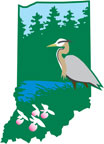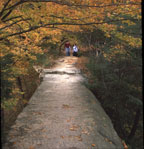
Indiana's system of Nature Preserves was established by a 1967 act of the General Assembly, called the 1967 Nature Preserves Act. The system's purpose is to provide permanent protection for significant natural areas within the state.
A natural area is an area of land and/or water which has:
- Retained or re-established its natural character
- Has unusual flora or fauna
- Or has biotic, geological, scenic or paleontological features of scientific or educational value
Areas which possess these qualities are set aside by dedicating them as nature preserves. Nature preserves are actually living museums, natural resources which contain a record of Indiana's original natural character.
Like other museums, they serve as a valuable record for scientific study. They also increase our understanding of our natural and historical heritage. In nature preserves, you can see Indiana as it was when the first settlers arrived.
Help us acquire new nature preserves in one of the following ways:
- Purchase an Environmental License Plate
- Donate to the President Benjamin Harrison Conservation Trust Fund
Preserve owners
Natural areas can become dedicated nature preserves only with the agreement of the land owner, the Department of Natural Resources and the Natural Resources Commission. Once a preserve is dedicated, it is protected in perpetuity from development which would harm its natural character.
The largest number of nature preserves are owned by various divisions of the Indiana Department of Natural Resources. Several city and county park and recreation boards also own preserves, along with a number of universities and colleges.
Several private conservation organizations have made valuable contributions to the nature preserve system acquiring and dedicating natural areas:
- The Nature Conservancy, owns and manages many preserves throughout the state.
- ACRES, Inc has been instrumental in acquiring and protecting natural areas in northeastern Indiana.
Nature Preserves are also owned and managed by a number of other Land Trusts:
Northwest Indiana
West Central Indiana
Central Indiana
- Central Indiana Land Trust – CILTI
East Central Indiana
- Whitewater Valley Land Trust - WVLT
Southwest Indiana
Southern Indiana
Division of Nature Preserve’s role
The Nature Preserve system is administered by the Division of Nature Preserves (DNP). DNP is charged with insuring that the natural qualities of preserves are protected. This may include:
- Prescribed burning
- Removing non-native plants
- Other management provided for in the Master Plan
- Maintaining boundaries and trails
DNP is also actively involved in inventorying the state for previously unknown natural areas, maintaining a registry of natural areas, and dedicating new preserves.
DNP's main purpose is to protect the best remaining natural areas in Indiana. Indiana's Nature Preserve law sets forth a process of dedication for significant natural areas. Those areas dedicated are permanently protected, to be preserved as pristine natural areas for all the people of Indiana.
Two programs
- The Indiana Natural Heritage Data Center, which works to locate and keep track of Indiana's rarest plants, animals and natural communities. The Natural Heritage Data Center maintains an extensive database of these elements of natural diversity. With this information, DNP can set priorities for the protection of natural areas in Indiana. The Indiana Natural Heritage Data Center is a part of an international network of Heritage Programs and Conservation Data Centers and is a member of NatureServe.
- The Lake Michigan Coastal Program works to enhance the State’s role in planning for and managing natural and cultural resources in the coastal region and to support partnerships between federal, state and local agencies and organizations. The Indiana Lake Michigan Coastal Program relies upon existing laws and programs as the basis for achieving its purposes.
Mission Statement
The mission of the Division of Nature Preserves is to identify, protect and manage an array of nature preserves and natural areas in sufficient numbers and sufficient sizes to maintain viable examples of all of Indiana's natural communities. Nature Preserves will also manage and maintain viable populations of endangered, threatened, and extirpated species. These activities will be conducted for the benefit of the natural communities, their representative species as well as the benefit of future generations.
The purpose of the Indiana Lake Michigan Coastal Program is to enhance the State’s role in planning for and managing natural and cultural resources in the coastal region and to support partnerships between federal, state and local agencies and organizations. The Indiana Lake Michigan Coastal Program relies upon existing laws and programs as the basis for achieving its purposes.
Nature Preserves of Indiana

Devil's Backbone at Pine Hills Nature Preserve.
There are more than 300 Nature Preserves dedicated under state law, Indiana Code 14-31-1. This represents more than 53,000 acres spread throughout Indiana. DNP works closely with many others in dedicating significant natural areas, for instance:
- DNR State Parks
- DNR Forestry
- DNR Fish and Wildlife
- Nature Conservancy
- Local land trusts
- County park systems
- Colleges and Universities
First preserve
The first dedicated nature preserve was Pine Hills Nature Preserve in Shades State Park in 1969. Since then, the nature preserve system has grown to be the most widely distributed system of protected lands in the state.
Accomplishments
- In 2017, DNP celebrated its 50th Anniversary.
- In 2012, Loblolly Marsh,the 250th Nature Preserve, was dedicated with the work and help of many partners, one of which was the Friends of Limberlost. Located in Jay County, this restored wetland complex was once part of the Limberlost Swamp written about by Gene Stratton-Porter in the early 20th century.
- In 2016, DNP and its partners celebrated the achievement of protecting 50,000 acres within the nature preserve system. Meltzer Woods in Shelby County is the last stand of old-growth forest to be protected in Indiana. Owned and managed by CILTI, this property was protected with the partnership of the Meltzer family and the President Benjamin Harrison Conservation Trust Fund programs.
Preserve management and regulations
More than any other reason, nature preserves are set aside to protect the plants, animals and natural communities which are found on them. Visitation is allowed to the extent that the features can tolerate it without deterioration.
Preserves are managed to maintain and/or restore natural ecological conditions, and as a general rule are open to the public for hiking and nature study, or by advance permission for scientific research. It is against the law to disturb or remove anything from a preserve without a special permit.
Please do not disturb or molest the plant and animal life you find: some species may very well be endangered or rare.
Prohibited activities include:
- Campfires
- Camping
- Picnicking
- Rock climbing
- Littering
- Vehicles
- Grazing by domestic animals
- Farming
- Logging
- Mining and quarrying
Rules for all DNR properties can be found in Article 8 of the Indiana Administrative Code.
Additional regulations may be posted at individual preserves. Staff from the DNP visit each preserve as often as possible, but must rely on reports from nature preserve visitors as well.
If you notice violations of these regulations or other management problems, or have other comments and suggestions, please contact the Division of Nature Preserves.
In preserves that have them, please stay on trails during your visit. This reduces erosion and damage to fragile plant communities.
Please view our List of Nature Preserves and then choose a specific county. Please note that some of the preserves listed may not have a parking lot and/or a hiking trail. For those without, please do not hesitate to contact us or the organization who owns the preserve if you have any questions about visiting the preserve.
